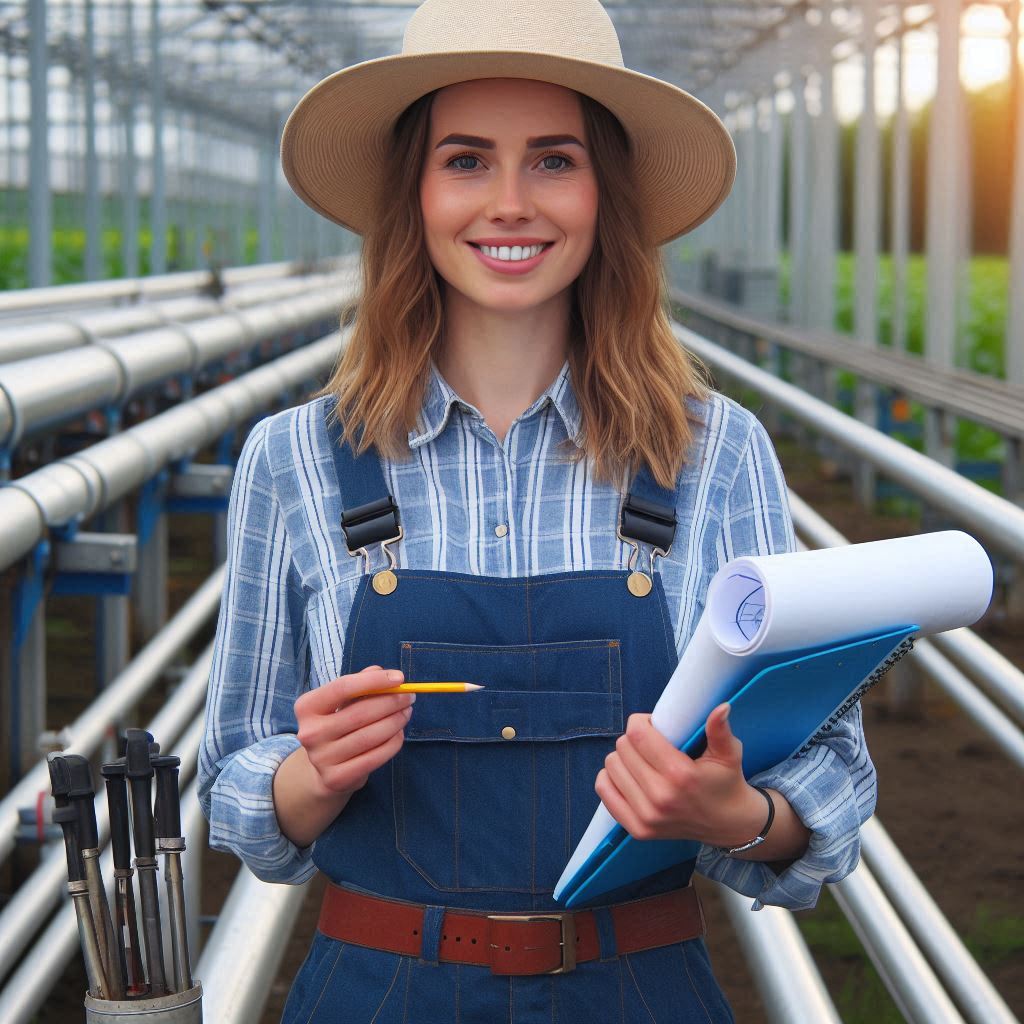Introduction
Agricultural engineering technology is vital for advancing modern farming practices.
It integrates engineering principles with agricultural sciences to enhance productivity and sustainability.
This technology addresses various agricultural challenges, from resource management to crop production efficiency.
As the agricultural sector faces increasing demands, technological advancements offer innovative solutions to these challenges.
The field of agricultural engineering is continuously evolving with the integration of cutting-edge technologies.
Innovations such as precision farming tools, data analytics, and automated machinery are revolutionizing how farms operate.
Precision farming uses GPS and sensors to monitor and manage crops with high accuracy.
This technology helps farmers apply inputs more efficiently, improving yield while minimizing waste and environmental impact.
Data analytics plays a significant role in farm management by providing actionable insights based on real-time data.
This technology helps farmers make informed decisions regarding planting, irrigation, and harvesting.
By analyzing data from various sources, such as weather patterns and soil conditions, farmers can optimize their practices to increase productivity and reduce costs.
Precision Agriculture
Definition and Explanation of Precision Agriculture
Precision agriculture refers to farming practices that use technology to optimize field-level management.
It integrates GPS, sensors, and data analytics to enhance crop production.
This approach involves collecting detailed information about soil, crops, and environmental conditions.
By analyzing this data, farmers can make informed decisions on planting, watering, and fertilizing.
Precision agriculture aims to apply inputs more accurately and efficiently, reducing waste and maximizing yields.
It also involves using variable rate technology to apply different amounts of inputs where needed.
This method improves overall farm productivity and sustainability.
Benefits of Using Precision Agriculture Techniques
Precision agriculture offers numerous benefits, including increased efficiency and productivity.
By using detailed data, farmers can target specific areas that need attention.
This leads to more efficient use of resources such as water, fertilizers, and pesticides.
With precise application, farmers reduce waste and minimize environmental impact.
Enhanced crop management results in higher yields and better quality produce.
Precision agriculture also allows for real-time monitoring and adjustments, improving responsiveness to changing conditions.
This approach helps in maximizing profits while promoting sustainable farming practices.
Examples of Technologies Used in Precision Agriculture
Several technologies play a crucial role in precision agriculture.
GPS (Global Positioning System) is used for accurate field mapping and guiding machinery.
It helps in precise planting and efficient use of resources.
Drones provide aerial imagery and real-time data on crop health and field conditions.
They allow farmers to monitor large areas quickly and identify issues such as pest infestations or nutrient deficiencies.
Sensors embedded in the soil measure moisture levels, temperature, and nutrient content.
These sensors provide valuable data for optimizing irrigation and fertilization.
Variable Rate Technology (VRT) adjusts the amount of inputs applied based on sensor data, ensuring optimal use.
Farm Management Software integrates data from various sources, enabling farmers to make informed decisions and manage operations effectively.
Precision agriculture represents a significant advancement in agricultural engineering technology.
It leverages GPS, drones, sensors, and software to enhance farming practices.
By providing detailed insights and enabling precise applications, these technologies improve efficiency, productivity, and sustainability.
Farmers benefit from reduced waste, increased yields, and better resource management.
As precision agriculture continues to evolve, it promises further innovations that will drive the future of farming.
These advancements ensure that agriculture can meet the growing global demand for food while minimizing environmental impact.
Read: US Tech Hubs Beyond Silicon Valley: Emerging Cities
Vertical Farming
Explanation of What Vertical Farming Is
Vertical farming is an innovative agricultural method that grows crops in stacked layers or vertically inclined surfaces.
This method contrasts with traditional horizontal farming by using vertical space efficiently.
Vertical farms often operate indoors or in greenhouses, where they can control environmental conditions.
They utilize hydroponic, aeroponic, or aquaponic systems to grow plants without soil.
By stacking layers of crops vertically, vertical farming maximizes space usage and reduces the footprint of agricultural operations.
This approach allows for year-round crop production, regardless of outdoor weather conditions.
Advantages of Vertical Farming in Terms of Space Utilization and Resource Efficiency
Vertical farming offers significant advantages in space utilization and resource efficiency.
By growing crops in stacked layers, it dramatically increases the yield per square foot.
This method allows for higher density farming within urban environments, where space is limited.
Vertical farming reduces the need for large horizontal fields, conserving valuable land resources.
In terms of resource efficiency, vertical farming uses less water compared to traditional farming.
Hydroponic and aeroponic systems recirculate water, minimizing waste.
Additionally, controlled environments reduce the need for pesticides and herbicides, leading to cleaner produce.
Vertical farms can optimize light and nutrient delivery, enhancing plant growth and productivity.
This method also cuts down on transportation emissions by locating farms closer to urban centers, reducing the distance food travels from farm to table.
Examples of Vertical Farming Systems and Technologies Being Utilized
Several advanced vertical farming systems and technologies are currently being utilized.
One prominent example is the use of hydroponic systems, which grow plants in nutrient-rich water rather than soil.
Companies like AeroFarms and Freight Farms use hydroponic systems to grow leafy greens and herbs efficiently.
Another example is aeroponics, where plants grow in air or mist environments with nutrient solutions.
Tower Garden, developed by the company Urban Cultivator, employs aeroponics to cultivate a variety of crops in vertical towers.
LED lighting technology is also a key component in vertical farming.
LED lights provide the specific wavelengths needed for plant growth and can be adjusted to simulate natural sunlight.
Companies like CropOne Holdings and Plenty use advanced LED lighting systems to enhance crop yield and quality.
Additionally, some vertical farms integrate robotics and automation to streamline operations.
Automated systems handle planting, harvesting, and monitoring of crops.
These technologies increase efficiency and reduce labor costs.
For instance, the vertical farm operator, Infarm, utilizes modular units with integrated automation for urban agriculture.
Therefore, vertical farming utilizes stacked layers and advanced technologies to maximize space and resource efficiency.
It reduces land use, conserves water, and minimizes the need for chemicals.
Examples of vertical farming systems include hydroponic and aeroponic setups, LED lighting, and automation technologies, all contributing to innovative and sustainable agricultural practices.
Read: The Journey: How to Become an Architect in the USA.
Robotics and Automation
Overview of Robotics and Automation in Agriculture
Robotics and automation are transforming agriculture by enhancing efficiency and productivity.
Robots handle tasks such as planting, harvesting, and weeding with precision.
Automated systems can operate continuously, reducing the need for manual labor.
These technologies integrate sensors, AI, and machine learning to perform complex tasks.
They optimize the use of resources and adapt to varying conditions.
Robotics can navigate fields autonomously, identify crops, and perform targeted actions.
Automation systems streamline workflows and improve overall farm management.
The integration of robotics in agriculture addresses labor shortages and increases operational efficiency.
Benefits of Using Robotics and Automation
Robotics and automation offer several benefits in agriculture.
First, they increase efficiency by performing repetitive tasks faster and more accurately than human labor.
Automated systems reduce the time required for planting, harvesting, and weeding.
They enhance precision, ensuring that tasks are completed with minimal errors.
This results in higher crop yields and better-quality produce.
Robotics can operate around the clock, leading to continuous productivity and reduced operational downtime.
Automation also decreases the reliance on manual labor, which helps address labor shortages.
By improving consistency and reducing human error, these technologies contribute to more reliable farming practices.
Examples of Robotic Technologies in Development
Several robotic technologies are being developed for agriculture.
Harvesting Robots are designed to pick fruits and vegetables with high accuracy.
These robots use sensors and AI to identify ripe produce and handle it gently.
Planting Robots automate the process of sowing seeds, ensuring precise placement and depth.
They can adapt to different soil types and seed varieties.
Weeding Robots utilize advanced vision systems to detect and remove weeds, minimizing herbicide use.
These robots differentiate between crops and weeds, ensuring targeted weeding.
Autonomous Tractors equipped with GPS and AI perform tasks such as plowing and planting with minimal human intervention.
Drones equipped with imaging technology monitor crop health and apply fertilizers or pesticides as needed.
These drones provide real-time data and targeted treatments, enhancing crop management.
Robotics and automation are revolutionizing agricultural engineering by improving efficiency, precision, and productivity.
These technologies handle tasks such as planting, harvesting, and weeding more effectively than manual labor.
With advancements in harvesting robots, planting systems, weeding technologies, autonomous tractors, and drones, agriculture is becoming more efficient and sustainable.
These innovations address labor shortages and enhance farm management, contributing to higher crop yields and better-quality produce.
As robotics and automation continue to evolve, they promise further advancements in agricultural technology, driving the future of farming.
Read: Exploring Architect Salary Trends: USA Analysis.
Transform Your Career Today
Unlock a personalized career strategy that drives real results. Get tailored advice and a roadmap designed just for you.
Start NowSmart Irrigation Systems
Explanation of Smart Irrigation Systems
Smart irrigation systems represent a significant advancement in agricultural technology.
These systems use sensors and data analytics to optimize water usage.
Sensors placed in the soil measure moisture levels and weather conditions.
The system processes this data to determine the precise amount of water needed.
This approach prevents overwatering and underwatering, ensuring crops receive the right amount of water.
Smart irrigation systems also integrate with weather forecasts to adjust watering schedules based on predicted rainfall.
These technologies can be controlled remotely through apps, providing farmers with greater flexibility and control.
Benefits of Using Smart Irrigation Systems
Smart irrigation systems offer several benefits, particularly in water conservation and crop yield.
By using real-time data, these systems minimize water waste.
Efficient water use leads to lower water bills and reduced environmental impact.
With accurate moisture measurements, crops receive the optimal amount of water, enhancing their growth and yield.
This technology also helps in maintaining soil health by avoiding excessive irrigation.
Furthermore, smart irrigation systems can improve overall farm productivity.
They allow farmers to focus on other aspects of farming while ensuring that irrigation needs are met efficiently.
Examples of Companies Developing Smart Irrigation Technologies
Several companies are at the forefront of developing smart irrigation technologies.
Netafim is a global leader known for its drip irrigation systems that integrate advanced sensors and control systems.
HydroPoint offers smart irrigation solutions that utilize weather data and soil moisture sensors to optimize water usage.
Rachio provides smart sprinkler systems that connect with weather forecasts and soil data to manage irrigation schedules.
Ceres Imaging uses aerial imagery and analytics to monitor crop health and optimize irrigation practices.
These companies are driving innovation in agricultural irrigation, making it more efficient and sustainable.
Smart irrigation systems exemplify the latest innovations in agricultural engineering technology.
By leveraging sensors, data analytics, and weather forecasts, these systems optimize water use and enhance crop yields.
Companies like Netafim, HydroPoint, Rachio, and Ceres Imaging are leading the charge in developing these advanced technologies.
Their contributions are crucial in advancing sustainable farming practices and improving agricultural efficiency.
As these technologies continue to evolve, they promise even greater benefits for water conservation and crop management.
Read: 5 Essential Software Tools Every US Architect Uses.

Biotechnology and Genetic Engineering
Overview of How Biotechnology and Genetic Engineering Are Impacting Agriculture
Biotechnology and genetic engineering are revolutionizing agriculture by enhancing crop performance and resilience.
These technologies enable precise modifications to plant genomes, leading to significant advancements.
Scientists use genetic engineering to develop crops with improved traits, such as better yields, enhanced nutritional value, and resistance to pests and diseases.
Biotechnology harnesses various techniques, including gene editing and molecular markers, to address agricultural challenges.
For instance, CRISPR technology allows for precise alterations to the DNA of crops, leading to specific improvements without introducing foreign genes.
This method speeds up the development of crops with desirable characteristics and accelerates their adoption in the field.
Benefits of Using Biotechnology for Crop Improvement and Disease Resistance
Biotechnology offers numerous benefits for crop improvement and disease resistance.
One major advantage is the ability to enhance crop yields.
Genetically modified crops can grow faster and produce more food per acre.
This increased productivity is crucial for feeding a growing global population.
Another benefit is the development of crops with built-in disease resistance.
Biotechnology enables the creation of crops that can withstand specific diseases or pests, reducing the need for chemical pesticides.
This resistance leads to healthier crops and a more sustainable farming environment.
Biotechnology also improves the nutritional quality of crops.
Scientists can enhance the vitamin and mineral content of staple foods, addressing nutritional deficiencies in populations worldwide.
For example, biofortified crops like Golden Rice have been engineered to produce higher levels of vitamin A, helping combat vitamin A deficiency in developing countries.
Examples of Genetically Modified Crops and Their Impact on Agriculture
Several genetically modified crops demonstrate the impact of biotechnology on agriculture.
Bt cotton is a notable example; it contains a gene from the bacterium Bacillus thuringiensis, which provides built-in resistance to cotton pests.
This modification has significantly reduced the need for chemical insecticides and increased cotton yields.
Roundup Ready soybeans are another example. These soybeans are engineered to be resistant to glyphosate, a common herbicide.
This resistance allows farmers to control weeds more effectively without damaging the crop, leading to higher productivity and reduced weed management costs.
Golden Rice, as mentioned earlier, is genetically modified to produce higher levels of vitamin A.
This rice has the potential to improve nutrition in regions where vitamin A deficiency is prevalent, making a significant public health impact.
In essence, biotechnology and genetic engineering are transforming agriculture by enhancing crop performance, disease resistance, and nutritional quality.
The benefits of these technologies include increased yields, reduced pesticide use, and improved nutrition.
Examples like Bt cotton, Roundup Ready soybeans, and Golden Rice highlight the positive impact of genetically modified crops on agriculture.
These innovations play a crucial role in addressing global food security and sustainability challenges.
Sustainable Agriculture Practices
Definition Of Sustainable Agriculture And Its Importance
Sustainable agriculture focuses on preserving environmental health and economic profitability while meeting the needs of the present without compromising future generations.
This practice is crucial as it helps in maintaining soil health, conserving water resources, and reducing greenhouse gas emissions.
Various technologies are being developed to promote sustainable agriculture practices and enhance the efficiency of farming operations.
Technologies for Promoting Sustainable Agriculture
Precision farming techniques such as GPS, drones, and sensors are used to monitor crop health and optimize input usage.
Soil health monitoring systems help in assessing soil quality and nutrient levels to make informed decisions on fertilization and irrigation.
Water management technologies like drip irrigation and rainwater harvesting systems minimize water wastage and improve water use efficiency.
Transform Your Career Today
Unlock a personalized career strategy that drives real results. Get tailored advice and a roadmap designed just for you.
Start NowIntegrated pest management strategies combine biological, cultural, and chemical control methods to reduce the use of pesticides and protect beneficial insects.
Examples of Sustainable Agriculture Technologies
The Soil Health Card scheme provides farmers with information on soil nutrient levels, enabling them to apply fertilizers judiciously.
Conservation tillage practices like no-till farming reduce soil erosion, improve soil structure, and sequester carbon in the soil.
Cover cropping involves planting cover crops during fallow periods to prevent soil erosion, suppress weeds, and improve soil fertility.
Agroforestry systems integrate trees into agricultural landscapes to enhance biodiversity, improve soil health, and provide additional sources of income for farmers.
Aquaponics combines aquaculture (fish farming) with hydroponics (growing plants without soil) in a symbiotic system that reduces water usage and nutrient wastage.
Solar-powered irrigation systems help farmers in remote areas access water for irrigation without relying on fossil fuels, reducing operational costs and environmental impact.
Vertical farming utilizes indoor vertical stackable trays to grow crops in a controlled environment, optimizing space and resource use while reducing the need for pesticides and herbicides.
Rotational grazing techniques involve moving livestock periodically through different pastures to prevent overgrazing, increase soil fertility, and improve forage quality.
Overall, sustainable agriculture practices and technologies play a vital role in ensuring food security, preserving natural resources, and mitigating climate change effects in the agricultural sector.
Data Analytics and Farm Management
Explanation of How Data Analytics is Being Used for Farm Management
Data analytics is revolutionizing farm management by providing actionable insights.
Agricultural engineers use data from various sources to enhance farm operations.
Sensors, drones, and satellites collect data on soil health, weather conditions, and crop growth.
This data is analyzed to optimize farming practices and improve efficiency.
Farmers can track crop performance in real-time and make informed decisions based on accurate data.
By integrating data analytics into farm management, agricultural engineers can predict trends, identify issues early, and enhance productivity.
Benefits of Using Data Analytics for Decision-Making in Agriculture
The use of data analytics in agriculture offers several benefits.
First, it enables precision farming by providing detailed insights into field conditions.
This allows for targeted application of resources like water, fertilizers, and pesticides, reducing waste.
Second, data analytics helps in predicting crop yields and managing risks.
Farmers can anticipate potential issues, such as pest outbreaks or nutrient deficiencies, before they impact crops.
Third, it supports resource management by optimizing water usage and reducing energy consumption.
Overall, data analytics enhances decision-making, leading to increased efficiency, higher yields, and more sustainable farming practices.
Examples of Farm Management Software and Tools Available
Several farm management software and tools leverage data analytics to support agricultural operations.
Tools like Ag Leader‘s SMS Software offer comprehensive farm data management solutions, including field mapping and crop analysis.
Trimble Ag Software provides precision farming tools for crop planning, yield analysis, and field management.
John Deere Operations Center integrates data from machinery and field sensors to optimize operations and maintenance.
Climate FieldView offers real-time data visualization and insights for better decision-making.
These tools enable farmers to analyze data from multiple sources, improving overall farm efficiency and productivity.
Data analytics is transforming farm management by offering detailed insights and supporting informed decision-making.
The benefits include precision farming, risk management, and resource optimization.
Farm management software like Ag Leader‘s SMS Software, Trimble Ag Software, John Deere Operations Center, and Climate FieldView provide valuable tools for analyzing data and enhancing agricultural practices.
These innovations drive efficiency and sustainability in agriculture, making data analytics a crucial component of modern farm management.
See Related Content: Environmental Engineering and Urban Planning
Conclusion
In this blog, we have examined several groundbreaking technologies shaping the future of agricultural engineering.
Biotechnology and genetic engineering are at the forefront of these innovations, significantly impacting crop performance and agricultural practices.
Techniques such as CRISPR gene editing allow for precise modifications, leading to crops with enhanced traits like disease resistance and improved nutritional value.
We discussed various examples of genetically modified crops that highlight these advancements.
Bt cotton, for instance, offers built-in pest resistance, reducing the need for chemical insecticides and improving yields.
Similarly, Roundup Ready soybeans, engineered for glyphosate resistance, enable more effective weed control, boosting productivity and lowering management costs.
Golden Rice, enriched with higher levels of vitamin A, exemplifies how biotechnology can address nutritional deficiencies and contribute to public health.
The potential of these technologies to revolutionize agriculture is immense.
They promise to enhance food security, increase crop yields, and reduce the environmental impact of farming practices.
By integrating these innovations, we can create more resilient and efficient agricultural systems that meet the growing demands of a global population.




